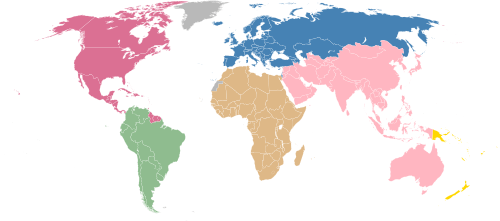Lesotho women's national under-20 football team
| Nickname(s) | Lilies | ||
|---|---|---|---|
| Association | Lesotho Football Association | ||
| Confederation | CAF (Africa) | ||
| Sub-confederation |
COSAFA (Southern Africa) | ||
| FIFA code | LES | ||
| |||
The Lesotho women's national football team represents the country in international competitions.
Background and development
Early development of the women's game at the time colonial powers brought football to the continent was limited as colonial powers in the region tended to take make concepts of patriarchy and women's participation in sport with them to local cultures that had similar concepts already embedded in them.[1] The lack of later development of the national team on a wider international level symptomatic of all African teams is a result of several factors, including limited access to education, poverty amongst women in the wider society, and fundamental inequality present in the society that occasionally allows for female specific human rights abuses.[2] When quality female football players are developed, they tend to leave for greater opportunities abroad.[3] Continent wide, funding is also an issue, with most development money coming from FIFA, not the national football association.[3] Future, success for women's football in Africa is dependent on improved facilities and access by women to these facilities. Attempting to commercialise the game and make it commercially viable is not the solution, as demonstrated by the current existence of many youth and women's football camps held throughout the continent.[1] Nada Grkinic was FIFA's international development manager. In 2007, one of her goals was to work on improving women's football in Africa and included work specifically pertaining to Lesotho.[4]
The national federation was created in 1932.[5] They joined FIFA in 1964. Their kit includes blue, white and green shirts, white shorts, and blue and white socks.[5][6]
Football is the third most popular sport in the country, behind netball and athletics.[5] Inside Lesotho, football is used to develop women's self-esteem.[7] In 2006, there were 5,200 registered female football players, of which 5,000 were junior players and 200 were senior players.[5] The number of female players has been increasing. In 2000, there were 210 registered players. In 2001, there were 350 registered players. In 2002, there were 480 registered players. In 2003, there were 750 registered players. In 2004, there were 2,180 registered players. In 2005, there were 4,600 registered players. In 2006, there were 5,200 registered players.[5] In 2006, there were 61 total football clubs in the country, with 54 being mixed gendered teams and 7 being all women teams.[5] Rights to broadcast the 2011 Women's World Cup in the country were bought by the African Union of Broadcasting.[8]
Team
The under-19/20 team is nicknamed the Lilies.[9] They did not play any games in 2002 or 2003. In 2004, they played 3 games. In 2005, they played 2 games. In 2006, they played 2 games.[5] In 2006, there was a change in FIFA structures for national under-19 teams, where they age group for the team was pushed up to under-20.[10] The team participated in the African Women U-20 World Cup 2008 Qualifying. They opened against Botswana in Maseru, tying 1-1. In the return match in Gaborone, they lost 1-3.[11] They competed in the preliminary rounds of the 2010 CAF FIFA U20 World Cup. In the preliminary round, they lost to Kenya away 2-0. At home, they tied Kenya 2-2. They did not make it out of the preliminary round.[12]
References
- 1 2 Peter Alegi (2 March 2010). African Soccerscapes: How a Continent Changed the World's Game. Ohio University Press. ISBN 978-0-89680-278-0. Retrieved 22 April 2012.
- ↑ Jean Williams (15 December 2007). A Beautiful Game: International Perspectives on Women's Football. Berg. p. 186. ISBN 978-1-84520-674-1. Retrieved 13 April 2012.
- 1 2 Gabriel Kuhn (24 February 2011). Soccer Vs. the State: Tackling Football and Radical Politics. PM Press. p. 34. ISBN 978-1-60486-053-5. Retrieved 13 April 2012.
- ↑ Northcroft, Jonathan (June 3, 2007). "Big game hunters - Football". The Sunday Times. London, England. p. 12. Retrieved 21 April 2012.
- 1 2 3 4 5 6 7 FIFA (2006). "Women's Football Today" (PDF): 114. Retrieved 8 June 2012.
- ↑ Pickering, David (1994). The Cassell soccer companion : history, facts, anecdotes. London: Cassell. p. 181. ISBN 0304342319. OCLC 59851970.
- ↑ Allen, Karen (2011-03-08). "BBC News - Has Lesotho bridged the gender gap?". Bbc.co.uk. Retrieved 2012-04-26.
- ↑ "FIFA Women's World Cup Germany 2011TM Media Rights Licensees" (PDF). FIFA. 2011. Retrieved 21 April 2012.
- ↑ de Kretser, Chris; Firkin, Katherine (January 13, 2010). "Pharaohs lead African assault". Herald Sun. Melbourne, Australia. p. 69. Retrieved 17 April 2012.
- ↑ "Women U-19/U-20 World Cup". Rsssf.com. 2011-01-21. Retrieved 2012-04-13.
- ↑ "African Women U-20 World Cup 2008 Qualifying". Rsssf.com. 2010-03-25. Retrieved 2012-04-13.
- ↑ "Fixtures - CAN U-20 women 2010 - CAF". Cafonline.com. Retrieved 2012-04-13.
